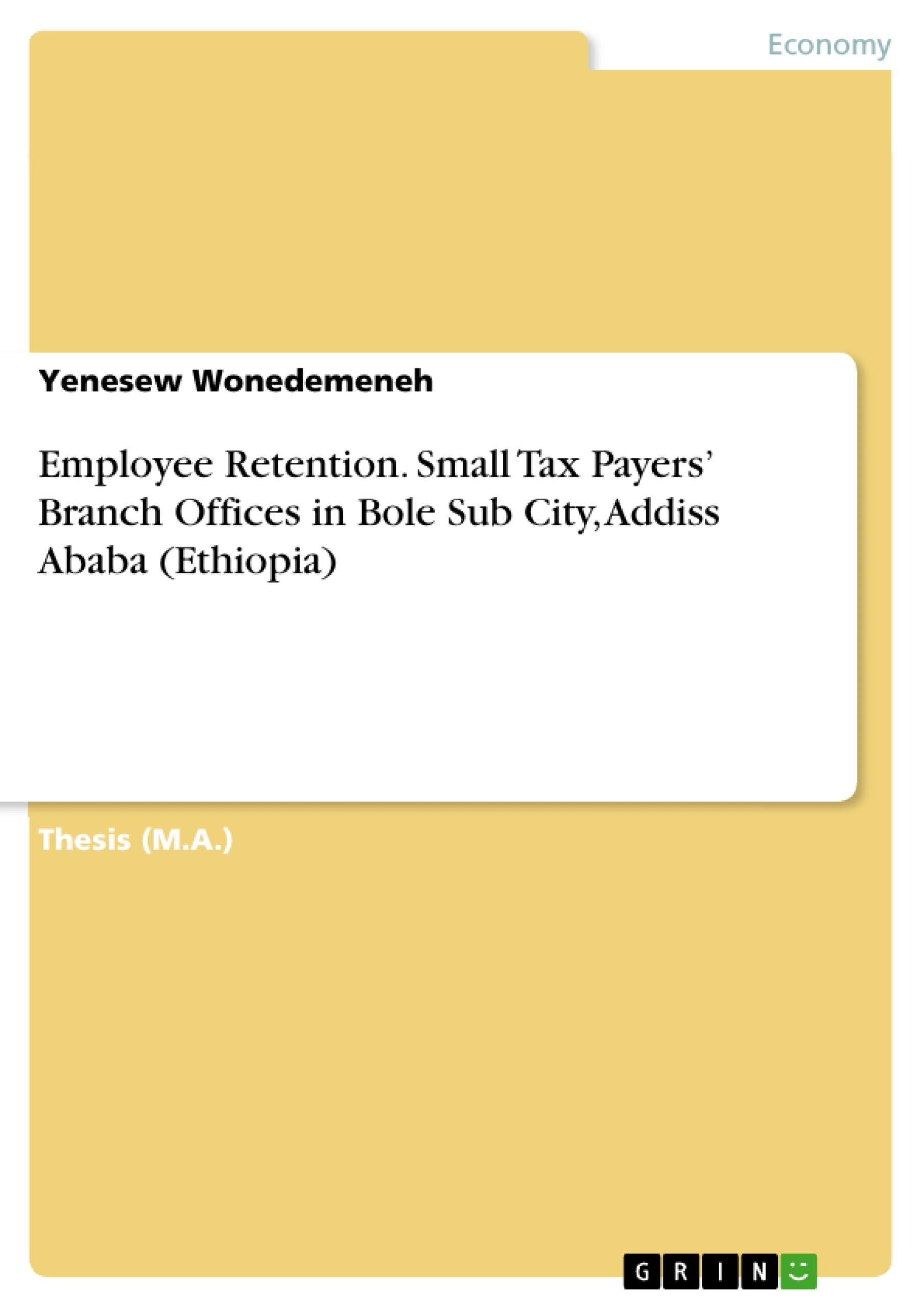The main purpose of this study was to assess the factors affecting employee retention in Bole sub city small tax payers’ office. The study also attempted to determine whether Compensation, training and development, Work-Life Balance, Employee Engagement and working environment affects employee retention in Bole sub-city small taxpayer’s branch office. In order to seek the research objectives data was collected through closed ended questionnaires.
The target population for this study was 438 employees working in the Bole sub-city small tax payers’ branch office. A sample of 210 respondents was drawn from the total population using simple random sampling technique. In order to analyze the data both descriptive and explanatory way of analysis were used to analyze the data. The descriptive analysis was analyzed facts using frequency, percentage, tables, figures, mean and standard deviation. However explanatory analysis was analyzed using correlation and regression.
The findings revealed that the Compensation, Training and Development, Work Life Balance and Work Environment in the organization have significant and positive effect on employee retention (p-values<0.05). A unit change in Compensation, Training and Development, Work Life Balance and Work Environment affect employee retention by 55.6, 16.3, 27.3 and 14.9 percent respectively. Even if Employee Engagements have positive effect on employee retention, it has insignificant effect on employee retention. Based on these result the researcher recommended that improving human resource management practice were necessary to retain employees of the organization. Therefore the organization must appropriately measures to retain key employees.
Inhaltsverzeichnis (Table of Contents)
- CHAPTER ONE.
- INTRODUCTION...
- Background of the study...
- Statement of the Problem......
- Objectives of the study..
- General Objectives..
- Specific Objectives.........
- Research questions.....
- Significance of the study..
- Scope of the study.
- Definition of key terms..
- Limitations....
- Organization of the Study...
- CHAPTER TWO....
- THE REVIEW OF RELATED LITERATURE..
- Theoretical Review..
- Job Embeddedness Theory..
- Maslow's theory.
- Herzberg's two factors theory.
- Adams Equity Theory (1965)...
- Concept of Human Resource Management..
- Concept of Employee Retention.........
- Empirical Literature Review...........
- Effects of Compensation on Employee Retention...
- Effects of Training and Development on Employee Retention..
- Effects Work-Life Balance on Employee Retention….…….………………...\li>
- Effects of Employee Engagement on Employee Retention…..\li>
- Effects of Work Environment on Employee Retention......
- Research Gaps............
- The Conceptual Framework..
- CHAPTER THREE..
- METHODOLOGY.
- Research Design......
- Research Approach..........\li>
- Population and Sampling Design.
- Target Population...........
- Sampling Design....
- Sample Frame...\li>
- Sampling technique.…………………..\li>
- Sample Size
- Source of Data..
- Primary Data sources...
- Data Collection Tools
- Methods of Data Analysis and Presentation........
- Methods of Data Analysis...........
- Methods of Data Presentation...
- Validity and Reliability Test..
- Validity Test
- Reliability Test..
- Ethical Considerations..
- CHAPTER FOUR..........\li>
- RESEARCH FINDINGS AND DISCUSSIONS.
- Response Rate.......
- Demographic Characteristics of Respondents.....
- Sex Category of Respondents..
- Age Category of Respondents....
- Marital Status of Respondents...
- Educational Background of the Respondents..
- Experience of Respondents.....
- Job Position........
- Descriptive Analysis of the Research...
- Employee Retention
- Factors Affecting Employee Retention…...
- Compensation
- Training and Development........
- Work-life Balance ……………...\li>
- Employee Engagement .....
- Work Environment...
- Inferential Analysis of the Data...
- Diagnostic Tests of Assumptions of Classical Linear Regression Model...
- Linearity Test
- Autocorrelation Test...
- Multicollinearity Test....
- Homoscedasticity Test...
- Normality Test.....
- Correlation and Regression Analysis of the Data...
- Correlation Analysis
- Regression Analysis
- CHAPTER FIVE.
- SUMMARY, CONCLUSIONS AND RECOMMENDATIONS..
- Summary.
- Conclusions...........
- Recommendations...
Zielsetzung und Themenschwerpunkte (Objectives and Key Themes)
This thesis aims to investigate the factors affecting employee retention in the Bole sub-city small tax payers' branch office in Addis Ababa, Ethiopia. The study seeks to identify the key factors influencing employee retention and their relative impact on employee turnover.
- Impact of Compensation on Employee Retention
- Role of Training and Development in Employee Retention
- Significance of Work-Life Balance for Employee Retention
- Influence of Employee Engagement on Employee Retention
- Effects of Work Environment on Employee Retention
Zusammenfassung der Kapitel (Chapter Summaries)
Chapter One provides a detailed introduction to the study, outlining its background, problem statement, objectives, research questions, significance, scope, definition of key terms, limitations, and organization.
Chapter Two explores the theoretical and empirical literature related to employee retention. It examines various theories, including job embeddedness, Maslow's hierarchy of needs, Herzberg's two-factor theory, and Adams' equity theory. The chapter also reviews existing research on the effects of compensation, training and development, work-life balance, employee engagement, and work environment on employee retention.
Chapter Three delves into the methodology employed for the study, outlining the research design, approach, population and sampling design, data sources, data collection tools, and data analysis techniques.
Chapter Four presents the research findings and discussions based on the collected data. It analyzes the response rate, demographic characteristics of respondents, and the descriptive and inferential analysis of the data.
Schlüsselwörter (Keywords)
Employee retention, factors affecting employee retention, compensation, training and development, work-life balance, employee engagement, work environment, Bole sub-city small tax payers' branch office, Addis Ababa, Ethiopia.
- Quote paper
- Yenesew Wonedemeneh (Author), 2019, Employee Retention. Small Tax Payers’ Branch Offices in Bole Sub City, Addiss Ababa (Ethiopia), Munich, GRIN Verlag, https://www.grin.com/document/509438



